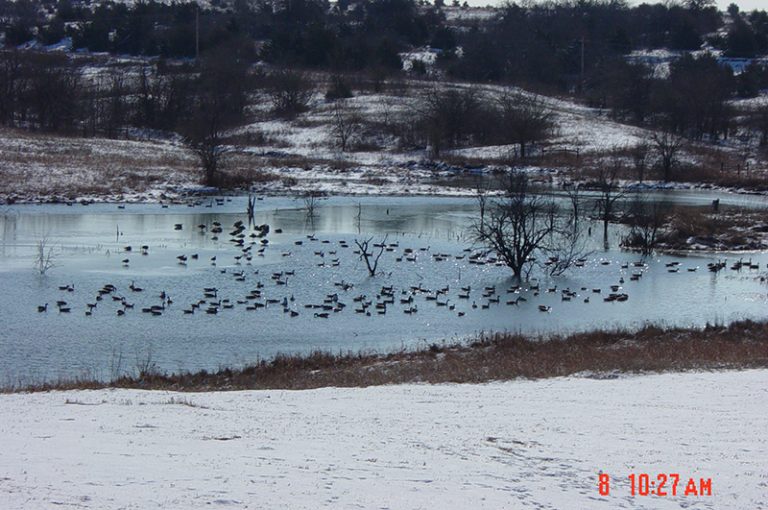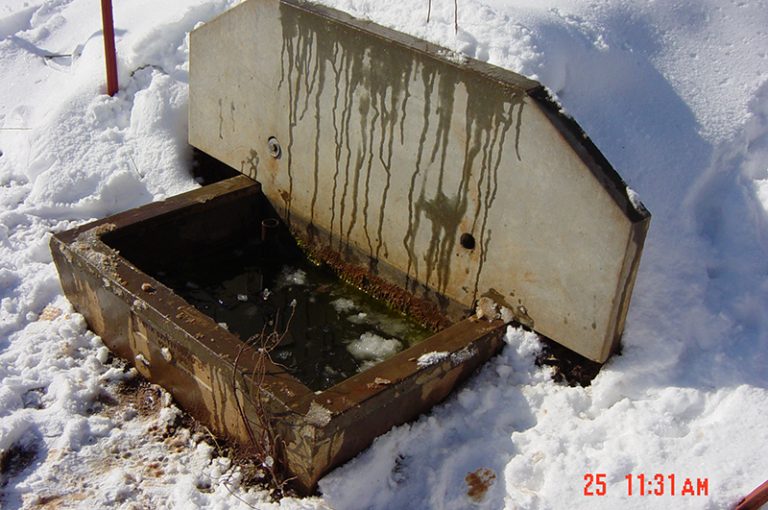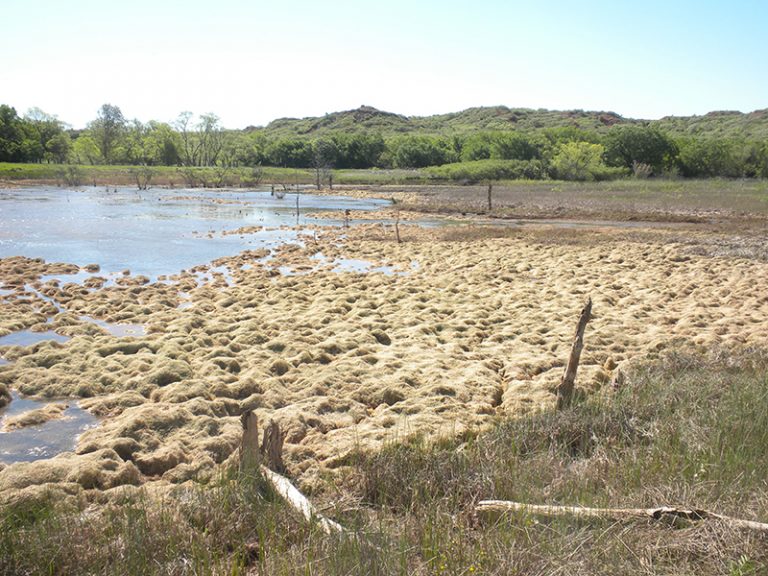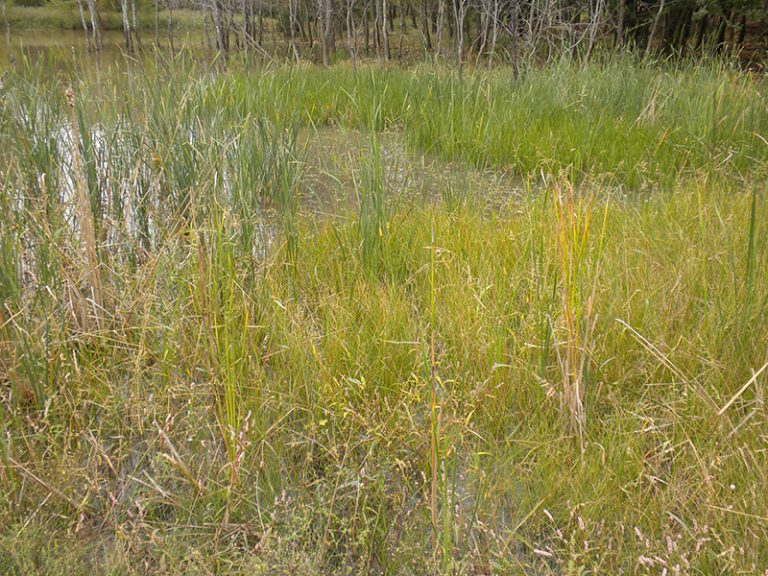Pond Management for Livestock, Fish and Wildlife
Introduction
Oklahoma has 316,806 ponds, which ranks Oklahoma as number two among states in number of ponds and number one among states in pond density.1 Ponds are highly valued by landowners whether agricultural, recreational, or homeowners because of their value for livestock water, habitat for fish and wildlife, and recreation. Property values are enhanced by the mere presence of ponds within eyesight of a residence.2
Pond Construction
Ponds constructed according to the USDA Natural Resources Conservation Service’s (NRCS) standards and specifications have been proven over many years to ensure a functional pond when completed. Dimensions of the dam are specific to the construction site and determined by an NRCS technician or engineer. The size of the dam and its spillways are based on the watershed’s characteristics including annual precipitation, soil type, slope, and vegetation. A properly constructed pond will include a primary spillway, which is usually a metal pipe through the dam, and an auxiliary spillway, which is usually excavated out of undisturbed soil to the side of the dam. Dense grass cover must be established and maintained on the auxiliary spillway to prevent cutting during overflows. Construction is the time to consider installing a freeze-proof stock watering tank below the dam. The dam and pond basin should be fenced to eliminate damage by livestock. This will increase the life of the pond and keep water clean and fresh for livestock, while also enhancing the pond’s value for fish and wildlife.

Fenced ponds provide excellent habitat for fish and some wildlife species such as waterfowl.
Pond Maintenance
The watershed and its vegetation are important factors in the design of the pond’s spillways, therefore it should be maintained in healthy condition. The watershed defines the area of drainage flowing into the pond and is sometimes overlooked as part of pond maintenance. The longevity of the pond and its usefulness will be determined by how the watershed is maintained. Maintaining vegetative cover to minimize bare soil and soil erosion also will minimize sediment that ends up in the pond. Encroaching plants such as eastern redcedar and other woody plants should be managed with prescribed fire (see circulars E-927, “Using Prescribed Fire in Oklahoma” and E-1010, “Oklahoma Prescribed Burning Handbook”). The watershed should also be properly grazed to order to prevent soil erosion and maintain desirable plants for livestock and wildlife.
To prolong the life of the pond, keep the dam free of woody plants by mowing and/or herbicides. Burrowing animals such as beaver, muskrat, gophers, and armadillos must be managed. If burrowing animals dig into the dam, it may cause a breach during high water, resulting in the loss of the dam and potential downstream damage to other properties. Burrowing animals also create a hazard when walking or driving on the dam. If these burrowing animals are observed causing damage, consider hiring a Nuisance Wildlife Control Operator licensed by the Oklahoma Department of Wildlife Conservation. Do not frequently drive across pond dams, as damage to the dam may occur.
Freeze-Proof Stock Tanks or Limited Access Watering Points
When livestock are present, fence the pond dam and basin and install a freeze-proof stock tank or provide a limited-access watering point. This will reduce turbidity and improve water quality for livestock, fish, and wildlife. It will also improve the appearance of the pond for recreation and enjoyment. Fencing and installing freeze-proof stock tanks or limited access watering points can also be done to existing ponds. Keeping cattle out of the pond with fencing can be problematic when livestock graze on fescue infected with the endophyte parasite. Such cattle experience elevated body temperatures and have been known to break fences to cool down by wading. All livestock should have access to trees or artificial shade for cooling during the summer months.
Freeze-proof stock tanks are usually made of concrete and come in 100-gallon and 200-gallon sizes. They are buried with only 25 percent of the tank exposed to the weather. The water flows from a pipe that runs through the dam and is underground to the tank. Water flow into the tank is controlled by a float and valve much like those found in toilets. Our experience with installing and maintaining these tanks suggests that the 200-gallon tank is a better choice because it is easier to install and maintain than the 100-gallon tank. The plumbing on a 200-gallon model comes into the side of the tank rather than from underneath as in the 100-gallon version. If the 100-gallon tank requires the pipes to be adjusted or replaced, it is very difficult to gain access and work under the tank. The larger volume of water in the 200 gallon tank is useful if large numbers of livestock are drinking at the same time. Freeze-proof tanks can be installed in the back of the dam, but in our experience, installing them a short distance away from the dam makes tank maintenance and livestock access much easier.
Freeze-proof tanks benefit the livestock and the rancher because:
- The animals drink cooler water in the summer and warmer water in the winter.
- The incidence of livestock sickness due to water-borne diseases and parasites such as coccidiosis and liver flukes is reduced.
- They eliminate chopping holes in the ice for livestock access to water in the winter.
- They eliminates risk of livestock falling through the ice and drowning. Livestock will usually not walk on ice unless it is covered by snow. Cattle have been lost to this infrequent occurrence.

Chopping holes in the ice is no longer an issue with freeze-proof tanks.

Freeze-proof tanks provide water to livestock in the winter that is warmer than surface water in the pond.
Limited access watering points are less expensive and easier to install than freeze-proof tanks, especially on existing ponds. However, they lack some of the benefits of freeze-proof tanks, which are discussed above. Fencing is installed around the pond to keep livestock out of the pond except at one access point. Livestock take turns entering and drinking according to herd dominance. Because cattle traffic will be heavy at the access point, it should be armored with gravel on top of geotextile. Angular gravel and a moderate slope are needed to ensure good livestock footing. A width of 20 feet for a small herd and 40 feet for up to 200 head is recommended. A floating fence can be constructed using light-weight livestock panels to ensure livestock exit after they have consumed their fill. If the floating fence is damaged by livestock, it may be necessary to protect it by means of a hot wire, powered by a solar charger.
Fencing Ponds to Benefit Fish and Wildlife
Most livestock watering ponds can be successfully managed for recreational fishing. Ponds an acre or larger in area without excessive muddiness can be stocked with largemouth bass, bluegill, and channel catfish. To manage for good fishing in such ponds, you will need to monitor size and “plumpness” of the fish caught and make sure that other fish species do not find their way into the pond. This means no bait bucket dumping or transfers of fish from other ponds or lakes by well-meaning friends. Existing fish populations are generally best eliminated by draining and drying of the pond, before fingerlings are stocked.

Livestock wading in the edge of a pond can create muddy water, cause erosion, and create animal health issues.
Ponds less than one surface acre in size can be stocked with channel catfish alone or in combination with hybrid bluegill. Stock channel catfish at 50 to 150 per surface acre and hybrid bluegill at up to 100 per surface acre. This assumes no feeding of the fish. Never put out tires or other spawning containers or catfish overpopulation is likely. Keep track of the numbers of catfish and hybrid bluegill removed and restock as needed. Fencing alone often results in clearing up of muddy ponds. If it does not, follow the steps in NREM-9206, “Common Pond Problems,” before stocking fingerlings. More information on fish pond management is available in NREM-9209, “Improve Fishing in Your Pond.” Fingerlings are available from the Oklahoma Department of Wildlife Conservation and private hatcheries. For details see, CR-9205, “Fingerlings for Pond Stocking.”
Ponds that have herbaceous (grass and forb) cover along the perimeter can provide important habitat for several species of wildlife. Birds such as marsh wrens, common yellowthroats, and red-winged blackbirds will utilize this cover for nesting. Other species such as the savannah sparrow will use the cover during the winter months. Additionally, forbs and legumes will provide forage for white-tailed deer and seed for various birds including the northern bobwhite. The wider the buffer area of herbaceous cover, the more wildlife use you can expect. However, there are some species that benefit from bare ground along the pond perimeter. Mourning doves readily use ponds in late summer and early fall for water. The ground must be nearly bare before they will use the water. Thus, having some limited area with minimal cover provides a water source for this species. You can further enhance the attractiveness of a pond by maintaining snags nearby as mourning doves prefer to perch in open snags prior to flying into a water source. Several species of shorebirds will utilize ponds (particularly large shallow ponds) during periods of drawdown (either natural or regulated). Moist, expansive mudflats that contain abundant aquatic invertebrates are important for these migrating shorebirds, especially during April-May and July-September. Even small mudflats will attract some species of shorebirds such as the spotted sandpiper. Additionally, ponds that contain abundant aquatic plant growth (usually in ponds with ample shallow water areas) are attractive to waterfowl. Both emergent (above water surface) and submergent (below water surface) plants are utilized as are the aquatic invertebrates that these plants harbor. In ponds with water control structures, a summer drawdown will often allow important waterfowl plants such as smartweeds and sedges to germinate. Additionally, cultivated plants such as Japanese millet can be planted on moist mudflats in mid-summer. Then, in late summer the pond can be allowed to refill, flooding these plants. Note that shallow ponds with abundant aquatic vegetation may not be appropriate for a healthy fishery. Summer draw downs also can be detrimental to fish as temperatures rise. Thus, you must consider your overall goals.
Benefits to Water Quality by Pond Fencing
Fencing eliminates damage to dams and shorelines by livestock hooves and overgrazing. The result is longer pond life and often elimination of muddiness (turbidity). A clearer pond will not only be more attractive but capable of supporting a better recreational fishery. With cattle no longer breaking down shoreline areas, the threat of invasion by cattails is reduced. When livestock no longer loaf in and around the immediate pond area, the amount of manure and urine reaching the pond is greatly reduced. Eliminating cattle excrement reduces toxic algae and often improves the palatability of water, potentially resulting in greater livestock gain.
Cost Share Assistance for Pond and Wetland Development.
Cost share assistance may be available for pond construction, pond restoration, and wetland development from the following agencies:
- USDA Natural Resources Conservation Service (NRCS)
- Oklahoma Department of Wildlife Conservation (ODWC)
- USDA Fish and Wildlife Service (USFWS)

Ungrazed vegetation around a pond protects water quality and provides excellent wildlife habitat for some species.
1 Fleming, J.P. and T.J. Stubbs. Management of small impoundments in North America. Unpublished manuscript.
2 Plattner, R.H. and T.J. Campbell. 1978. A study of the effect of water viw on site value. Appraisal Journal 46:20-25.
Terry Bidwell
Professor and Extension Specialist
Rangeland Ecology and Management
Marley Beem
Assistant Extension Specialist, Natural Resources and Aquaculture
Dwayne Elmore
Assistant Professor, Wildlife Ecology and Management
David Engle
Thomas E. Berry Professor
of Integrated Water Research and Extension
Director, Water Research and Extension Center
